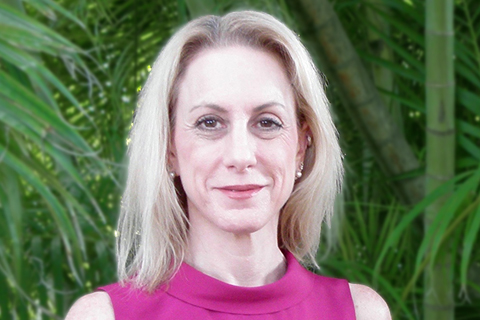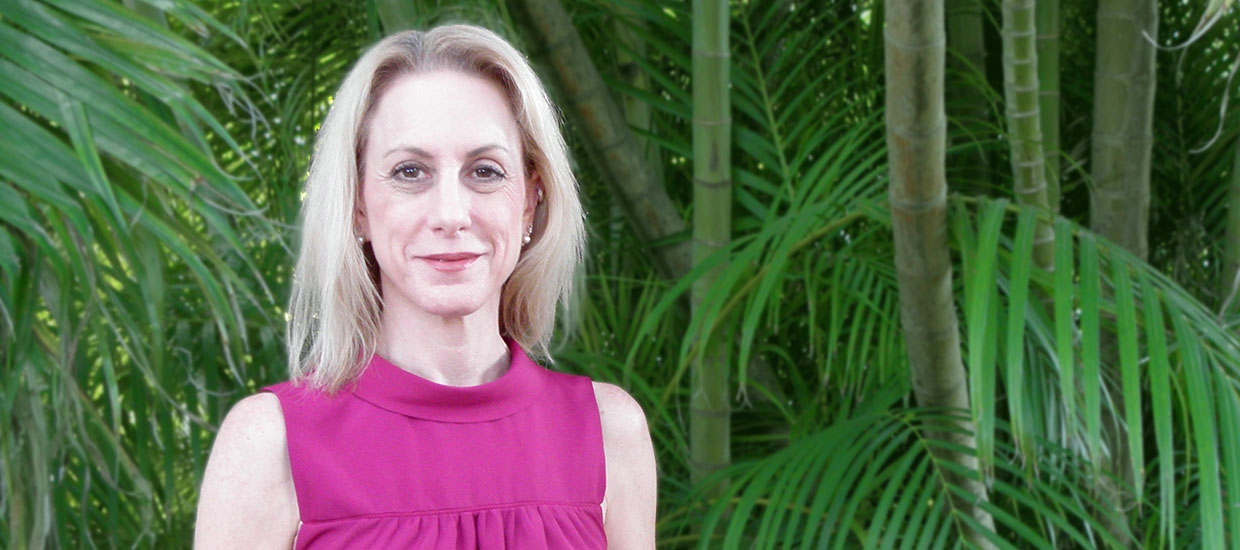Creative Arts teacher Jen Karetnick, M.F.A. ’96, wrote "The 500 Hidden Secrets of Miami – a guide to the best local finds through the eyes of a savvy local," showcasing the best that Miami has to offer. Within the book, there are a few University of Miami gems, including the Gifford Arboretum, Cosford Cinema, and the Campus Store.
In addition to her recent publications, Karetnick has written, co-written and edited 15 other books - a mixture of seven poetry books, three cookbooks, two guidebooks a book on fashion design and two anthologies. “Poetry is my first love,” Karetnick said, “but it's followed closely by narrative writing, so I do enjoy non-fiction work immensely.”
It’s that range of talent that provided the opportunity for Karetnick to write "The 500 Hidden Secrets of Miami," a guidebook that is published in many cities, assembled and written by a seasoned local. She draws inspiration from her passion and connection to the environment here in Florida.
How does your love for the environment impact your work?
I feel like you can't live in South Florida without paying attention to the environment. At first, when I moved down here in 1992, I was simply fascinated by it because it was so different from where I had grown up in New Jersey. The Everglades, the beaches, even the front lawn - these were magical places. It wasn't long before I saw how carelessly people treated them and how much they were taken for granted. Now, 26 years later, I'm incensed by our politicians and how they are bought by lobbies to destroy the habitat and deny climate change. In between those two poles - passion and rage - there's often an opportunity to write and effect change. Even when I'm writing something as instructional and perhaps mundane as a guide book or a cookbook, I try to focus readers' attention on something I care about and I think they should care about. Less the Instagrammable Ice Cream Museum - although of course there's room enough for that, too - and more the arboretum or garden that has gone unnoticed. I see it as an opportunity to write about what's necessary, about where the public eye should go, and about where tourist dollars should be spent in order for our natural resources to survive. It's one very tiny way of fighting back.
As a teacher, how does your love for art and education connect?
Most creative writing M.F.A. degrees include some form of teaching or tutoring training. Both my first M.F.A. in poetry, which I earned at University of California, Irvine, and my second in fiction, which was the one I received from University of Miami, included a teaching assistantship. I was teaching my own classes at both schools in composition and, after I graduated UM, in creative writing. I also taught at Barry University. But at some point, I had two small children and a full-time career in journalism, and adjuncting became impractical, for money and logistical reasons, so I gave it up. I returned to teaching full-time as the director of creative writing of school for the arts in 2009, when a position unexpectedly fell into my lap. It was a confluence of events: The economy was bad and journalism was failing; my kids were older and in school; and I'd been trained to teach and enjoyed it. It's been great. My students are thirsty learners and they're superior poets and writers. It's knowledge that they truly want, so it's easy to teach it to them.
How has your degree at UM helped you pursue your dreams?
I had an M.F.A. in poetry before I came to UM, and that taught me how to be very picky with my words and images. I was also already working as a restaurant critic for Miami New Times. So, I had a couple of genres under my belt. But I had never gone to journalism school, and was essentially learning on the job. My time at UM in the fiction program, being educated by professors like Lester Gorin, taught me how to write long-form pieces, how to find and resolve conflicts both big and small in narrative. It gave me the confidence not only to write fiction but to write personal essays and other kinds of journalism - travel, specifically, followed by parenting and other kinds of lifestyle journalism - that I'm not sure I would have tried otherwise. It taught me that I could be a writer of all kinds - even a playwright, which I also taught myself so that I could teach my students - and that there was no reason to be pigeonholed. Since there was such generosity of spirit in the English/Creative Writing department at UM, I was also permitted to take poetry classes even though it wasn't what I was technically there for. So, I sat in on Maxine Kumin's class, which boosted my poetry a great deal, and John Balaban's class, which also helped me - just being around him when he was program director was terrific, because of his sense of humor and his natural kindness - and I made lifelong friends, some of whom are still at UM teaching creative writing.
Your book is full of UM Alumni owned businesses and University of Miami gems; tell us more:
Once a 'Cane, always a 'Cane! It probably helps that my husband went to medical school at University of Miami, and that my daughter is hoping to transfer to UM from where she is now, and that my son, who is a junior in high school, loves all 'Canes sports without prompting. So, we're a 'Canes family! But promoting isn't pandering. If I thought the Lowe Art Museum and the Cosford Cinema were just mediocre, they wouldn't be in the book. They really are valuable to the community. As for the bookstore, well, where else are you going to get your turnover chain shirts to wear to the football games? You have to know where to find your gear!
Special thanks to anyone who helped in The Hidden Secrets of Miami?
The one thing I really love about this guidebook, which most guidebooks don't have, is the photography. Valerie Sands, who also did the images my Mango cookbook, did a lot of work traveling all over Miami-Dade County - and beyond - to get some great shots for the book. The images give it some additional color that words alone can't do. It's just one of the elements that makes 500 Secrets a step above the ordinary guidebook.
Also, any time I got stuck trying to think of one more venue or filling out a category, I asked my daughter or son, their friends, or my students. I know people like to disregard this generation, but anyone who's a high school or college-age teen or young adult right now - they know what's going on. If there's fun to be found, they're there. And I think we can all use some fun right about now.
You can find Jen’s books on Amazon or Barnes & Noble or on her website: jkaretnick.com.





